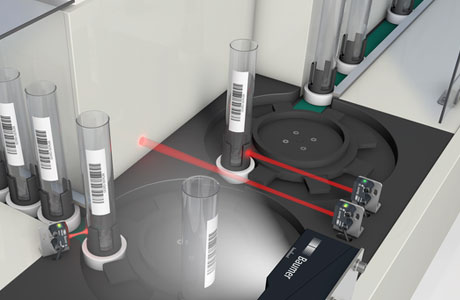Key Takeaway
Photoelectric sensors use a wider beam of light, making them ideal for general detection tasks but less effective for small objects or long distances. They are versatile and suitable for many applications.
Laser sensors, on the other hand, have a narrow and precise beam. This makes them ideal for detecting small objects and providing accurate measurements over long distances. Laser sensors excel in applications requiring high precision, while photoelectric sensors are best for broader detection needs.
Key Differences in Technology Between Photoelectric and Laser Sensors
The first step in comparing photoelectric and laser sensors is understanding how each sensor works. Photoelectric sensors detect objects using a beam of light, typically infrared or visible light, and sense the reflection or interruption of that beam. These sensors are widely used because they are versatile and can detect a broad range of objects, regardless of their material.
Laser sensors, on the other hand, use a focused beam of laser light to detect objects with greater precision. Lasers provide a much narrower and more concentrated light beam than standard photoelectric sensors, allowing them to detect even the smallest objects with high accuracy. This is one of the reasons laser sensors are often used in high-precision applications.

When to Use Laser Sensors Over Photoelectric Sensors
Laser sensors excel in situations where extreme precision is needed. Because they offer such a focused beam, laser sensors can detect very small objects or details that a standard photoelectric sensor might miss. This makes them ideal for applications like precision measurement, alignment, and detecting very fine or thin materials in industries like electronics manufacturing or medical device production.
Additionally, laser sensors are excellent for detecting objects over longer distances while maintaining high accuracy. They can detect objects from farther away and with better resolution compared to photoelectric sensors, making them useful in industries like automotive manufacturing or aerospace, where accuracy over distance is critical.
However, it’s important to note that laser sensors are typically more expensive than photoelectric sensors. So while they offer superior performance in certain areas, their use is often limited to applications where their precision and range justify the higher cost.
Comparing Accuracy, Range, and Cost of Photoelectric and Laser Sensors
When comparing photoelectric sensors to laser sensors in terms of accuracy, range, and cost, several factors come into play. Laser sensors are generally more accurate because their light beam is much narrower and more focused. This allows them to detect smaller objects or measure with a higher degree of precision. For example, laser sensors can be used to measure the thickness of materials or detect tiny components in electronic assemblies, where even the smallest variation can impact performance.
In terms of range, both sensor types can detect objects at varying distances, but laser sensors have the advantage when it comes to long-range detection. Laser beams remain focused over greater distances, whereas photoelectric sensors, which use a broader light beam, may lose accuracy at longer ranges.
Cost is where photoelectric sensors have the upper hand. They are generally much more affordable and can be used for a wide range of applications without the need for the extreme precision that laser sensors offer. If your application doesn’t require ultra-high accuracy or long-range detection, photoelectric sensors are often a more cost-effective solution.
Advantages of Laser Sensors in Precision Applications
The biggest advantage of laser sensors lies in their precision. In industries where even the smallest deviation can lead to errors, laser sensors are indispensable. They offer unparalleled accuracy in detecting fine details, making them ideal for tasks like quality control, thickness measurement, and part alignment. In the electronics industry, for example, laser sensors can be used to measure the exact positioning of small components, ensuring that each part is perfectly placed.
Laser sensors are also used in applications where precise distance measurement is critical. Their narrow, focused beam allows for highly accurate distance calculations, which is why they are commonly used in robotic systems and automated machinery that requires precise positioning.
Additionally, laser sensors can detect objects over long distances without losing accuracy. This makes them particularly useful in industries like aerospace or automotive manufacturing, where parts need to be detected or measured from far away while maintaining a high degree of accuracy. In short, laser sensors are the go-to solution for any application where precision is paramount.
Key Applications Where Photoelectric Sensors Outperform Laser Sensors
While laser sensors are known for their precision, there are many cases where photoelectric sensors outperform them. One of the main advantages of photoelectric sensors is their versatility. They can detect a wide variety of objects, including transparent or reflective materials, which laser sensors might struggle with. This makes photoelectric sensors a better option for applications like packaging or material handling, where the objects being detected vary in shape, size, and material.
Photoelectric sensors are also more reliable in environments where dust, moisture, or vibrations might interfere with the narrow beam of a laser sensor. In such conditions, photoelectric sensors can maintain their performance with less need for calibration or adjustment.
Another area where photoelectric sensors have the upper hand is cost. For applications that don’t require the pinpoint accuracy of a laser sensor, photoelectric sensors offer a more affordable solution. They are widely used in industries like food and beverage production, logistics, and general manufacturing, where detection is important, but ultra-high precision is not always necessary.
Conclusion
Deciding between photoelectric sensors and laser sensors ultimately comes down to the specific needs of your application. Laser sensors offer unmatched precision and range, making them ideal for high-accuracy tasks in industries like electronics, aerospace, and automotive manufacturing. However, they come with a higher price tag and may be overkill for applications that don’t require such precision.
On the other hand, photoelectric sensors are more versatile, affordable, and well-suited for general industrial applications. They can detect a wide variety of materials in different environmental conditions, making them a reliable option for tasks like object detection, material handling, and packaging.
